JEAN MIOTTE
Exhibition September – October 2022
JEAN MIOTTE
The freedom of gesture bursting through colour
Lydia Harambourg, art historian
In the summer of 2004, Jean Miotte welcomed me to his estate in Pignans, in the Var region of France. A major artist and icon of French painting in the second half of the 20th century, this exceptional figure of the lyrical abstraction movement – with its endless variations – captured movement as the very essence of life. After crossing a pine forest with its intoxicating fragrances, the studio appeared in a rare display of dynamic, sonorous and colourful flamboyance.
Once over the threshold, I was met by an eye-catching flurry of colours. The awareness of the ultimate joy of sharing in the expression of free and spontaneous creativeness would be difficult to shake. The painted work emerged in the fullness of the need to paint as a revelatory act concerning the accomplishment of an existential experience through the singular nature of its language.
Jean Miotte’s painted works deliver a style of lyricism whose energy is conveyed by an original gestural intoxication that structures the impenetrable marks and their rhythms in a spatial labyrinth, the challenges of which the painter overcame with elements specific to his pictorial explorations. The artist’s simultaneous use of the brush, the spatula and the knife contribute to an effervescence – in both form and colour – whose tensions can be felt in a space that is unusual (the theme of the title of a 1949 painting by the artist) and yet no less controlled, as a response to the precise nature of the gestures applied.
The fluid space is crossed by powerful expanses of solid colour that are stretched to smithereens, forming hemmed waves gouged by ruptures that bear witness to the complex relationship that is maintained with sensory reality and the philosophical and spiritual experience with regard to the metaphysics of the image. Jean Miotte’s style of painting is inextricably linked to a universe governed by contradictory and dualistic forces – between the vitality, transparency and density of colour and the clarity of a cursive style of execution that he intended to make visible without resorting to mere appearances. While arabesques were featured in his work from a very early stage (he took part in the first Paris Biennale in the “Informels” section in 1959), they were never decorative, much less figurative or expressionistic.
His work is a projection born of conflicting tensions, the unitary movement of which the artist examined and questioned.
While travelling in China and Japan, Miotte observed parallels in writing between the creative worlds in the West, or America, and the Far East. True to himself, Miotte’s art is the expression of an inner life that alternated between violence and refinement, serenity and anxiety, fervour and revolt. The vision of his art gave it all its authenticity and allowed him to escape time through a form of gesture that came from within, in harmony with a universe in motion that became the purest form of expression of the painter.
Miotte became aware very early on that the pictorial universe he strove to achieve held its strength in a semantic field in he considered gesture as the “I” who painted: I am painting.
To give expression to that gesture that celebrates painting, he drew on colour in its richest, most vibrant accents and sonorous tones, sharpened to the point of risking a fall into a void embodied by a series of whites that plunge us into space. It was on the basis of a form of logic inherent to chromatic value that Miotte gave pride of place to white, which “radiates and erases boundaries”. This white is diffused over the entire surface of the canvas and provides order to the space of the painting, which is open but no longer reduced to the “all-over” style. Turned into light, the white is fragmented, broken up over the colourful fluctuations of a palette dominated by the primary colours – red, blue and yellow – and their relationship to chiaroscuro, white, black and grey.
The 1970s and 1980s were conducive to a scattering within the pictorial field, which was open to a new cycle centred on the theme of metamorphosis. The explosion of forms that resulted revitalised the vocabulary of the painter. Eccentric, generous and dynamic forms achieved through a play on convolutions recall Miotte’s lifelong interest in choreography. His vocabulary explains his approach, which tends towards two extremes: a form of writing at the paroxysm of thought and sensation, and an exuberant spontaneity.
Given the conflicts between the Paris School and the New York School (Miotte lived in New York for part of the year, where he had a studio), it may be concluded that the artist who exhibited in Paris in the 1960s with Riopelle, Sam Francis and Joan Mitchell created his own style from a continuous and unceasing process of evolution – a pictorial language in its own right, which he rendered into a distinctive, unique and immediately identifiable work.
I would leave Jean Miotte’s studio in Pignans with the feeling that I was taking a little of the spirit of the studio and the secret of his painting away with me.

Lydia Harambourg and Jean Miotte, Pignans, France, August 2004

Lydia Harambourg and Jean Miotte, Pignans, France, August 2004
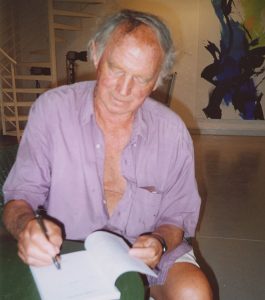
Jean Miotte in his studio, Pignans, France, August 2004
EXHIBITED ARTWORKS

Untitled – 1984
Acrylic on canvas
130 x 90 cm – 51.2 x 35.4 in.
Signed ‘Miotte’ lower left
Signed ‘Miotte’ on reverse
“No imitation, no reproduction, but the internal event finds its expression in the colours and a gestural dynamic… Miotte’s painting is a place where the contradictions of our age are no longer expressed in a dualist way…. In this sense, Jean Miotte is an important creator of new forms.”
Castor Seibel
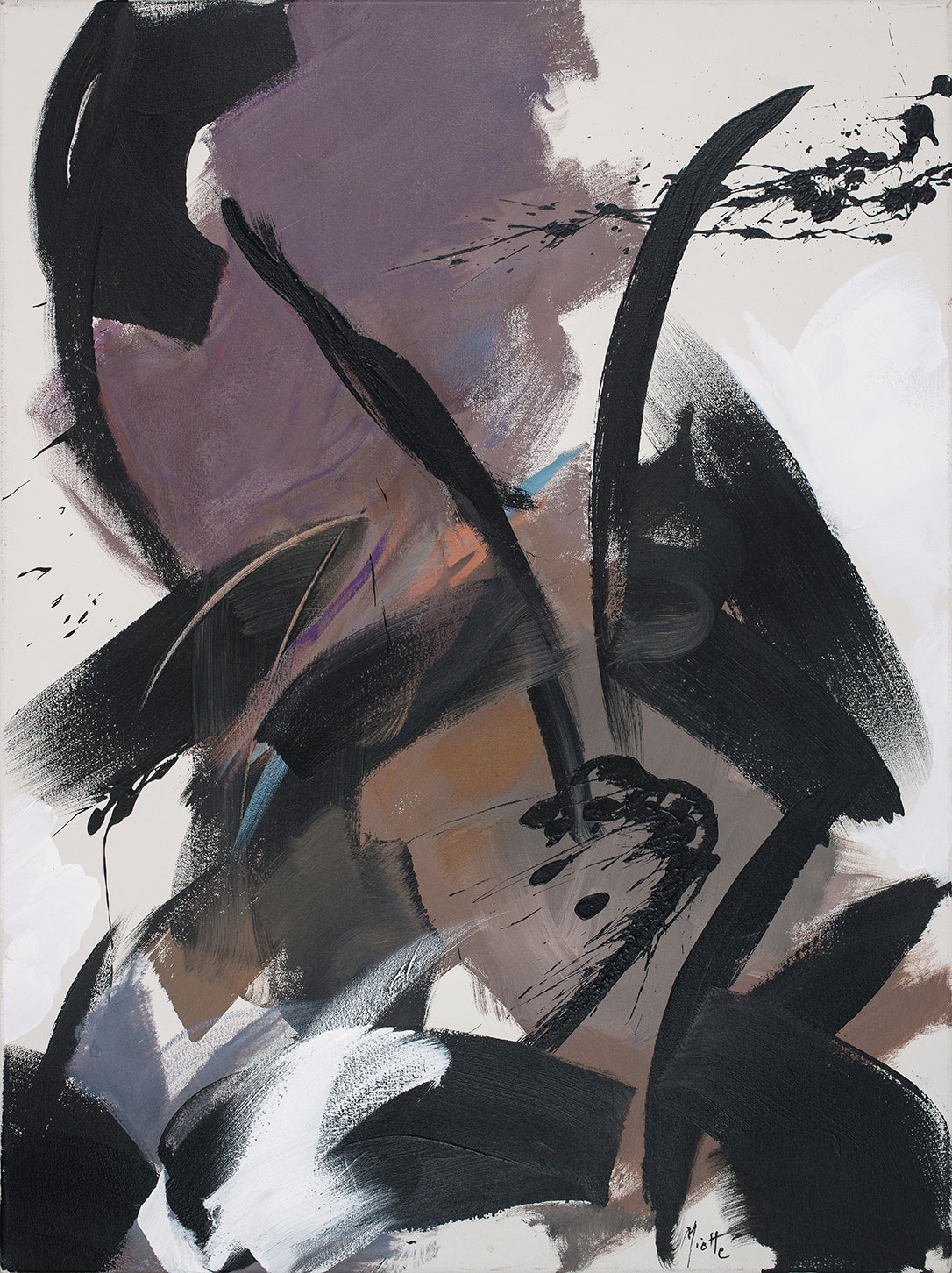
Ma mèroire – 1990
Acrylic on canvas
120 x 90 cm – 47.2 x 35.4 in.
Signed ‘Miotte’ lower right
“Result of internal conflicts, my painting is a projection; a succession of a cute moments where creation happens in full spiritual tension. Painting is not a speculation of the mind or the intellect, it is a gesture that is carried within.”
Jean Miotte

La Chaîne des êtres – 1991
Acrylic on canvas
81 x 100 cm – 31.8 x 39.4 in.
Signed ‘Miotte’ lower left

Untitled – 1991
Acrylic on canvas
130 x 97 cm – 51.2 x 38.2 in.
Signed ‘Miotte’ lower right
“the orchestration of a world that explodes”
Karl Ruhrberg

Untitled – 1992
Acrylic on canvas
195 x 374,5 cm – 76.8 x 147.4 in.
Signed ‘Miotte’ on reverse
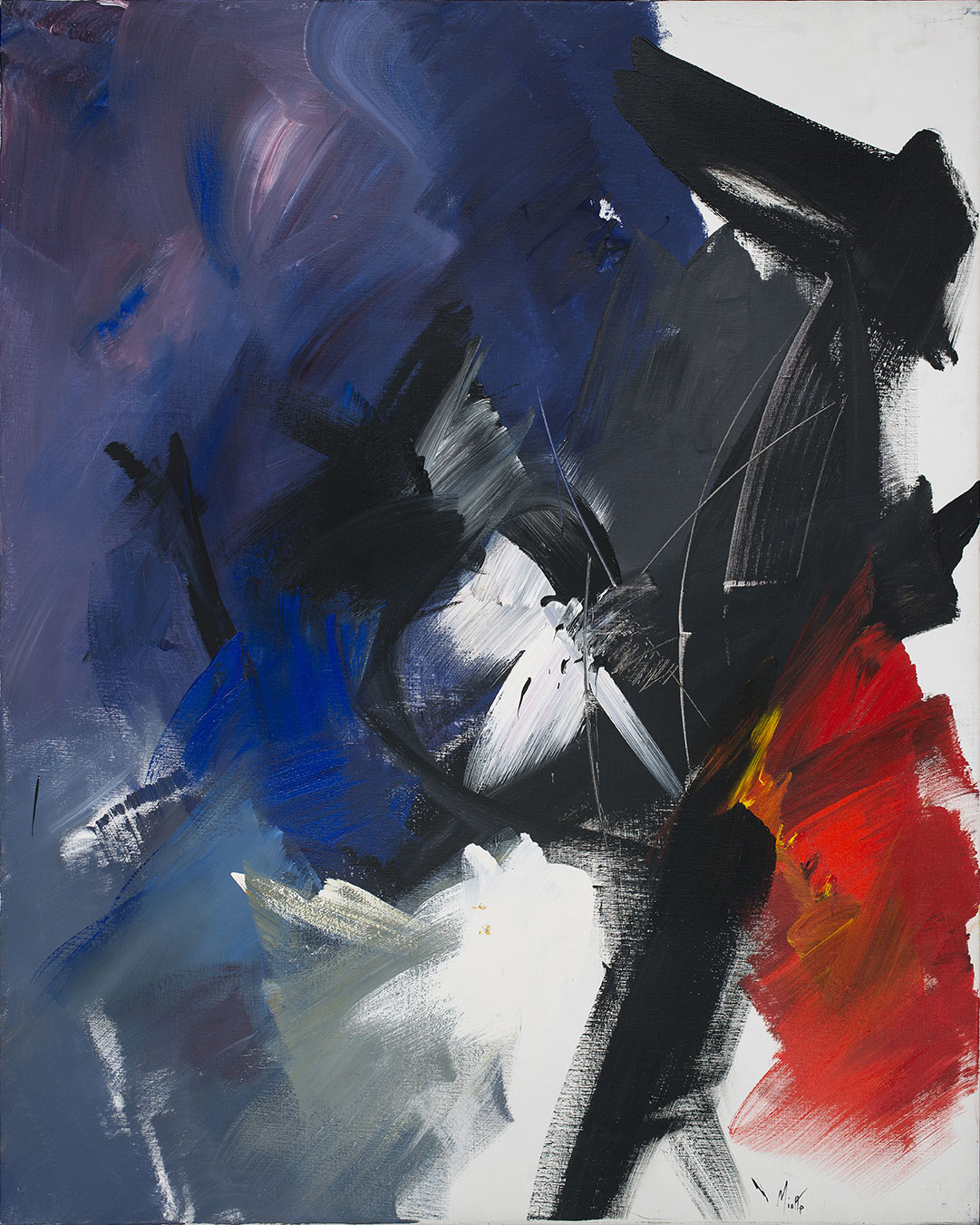
Untitled – 1994
Acrylic on canvas
162 x 130 cm – 63.8 x 51.2 in.
Signed ‘Miotte’ lower right
“The names of the artists who, with their lyricism, are an exception to the general rule of coldness…Jean Miotte, by whom bright and airy painting transmits an undeniable emotion”
Alain Jouffroy
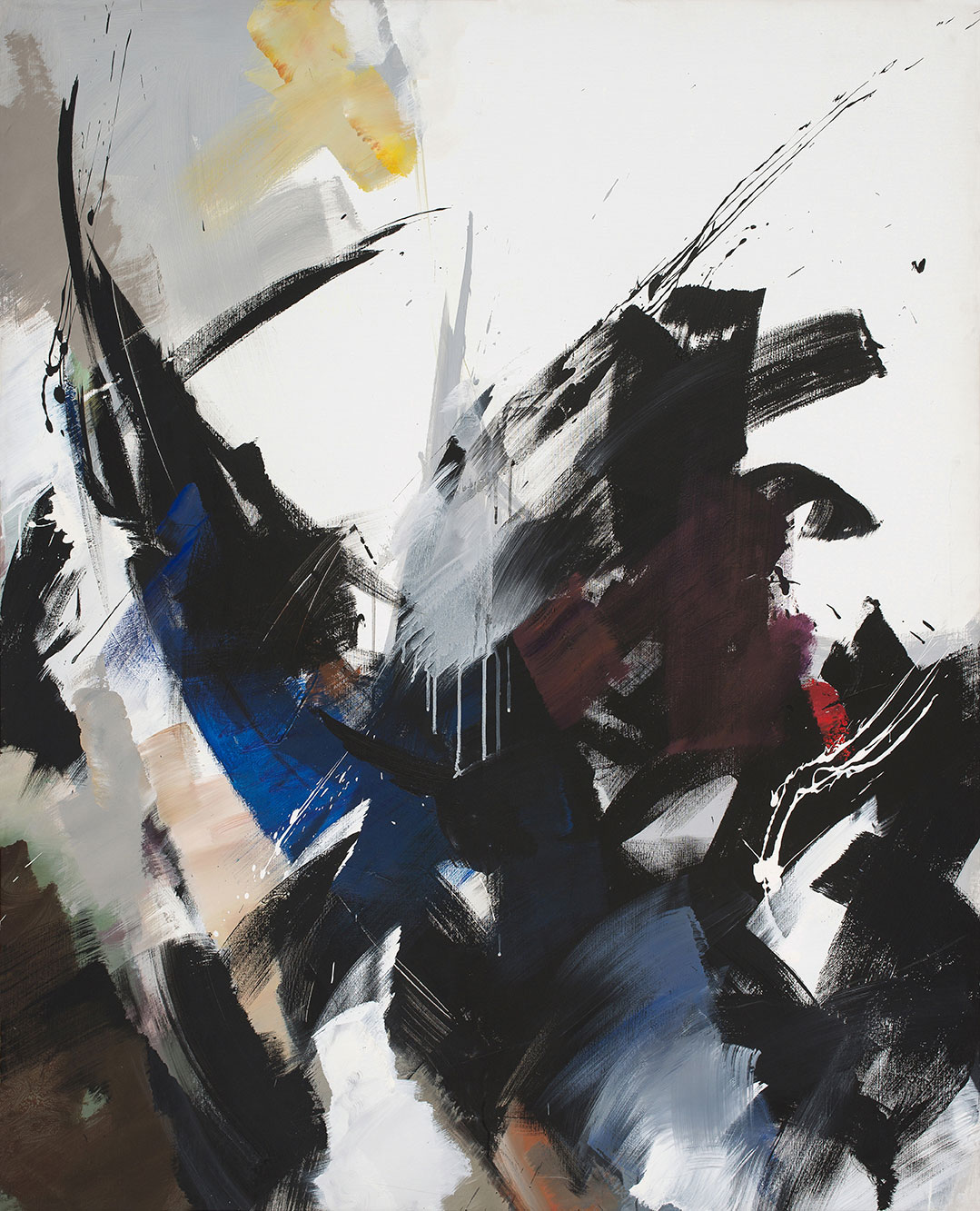
Untitled – 1996
Acrylic on canvas
Signed ‘Miotte’ on reverse
“total harmonisation in the tension of life itself with all its complexities and contradictions.”
Roger van Gindertael
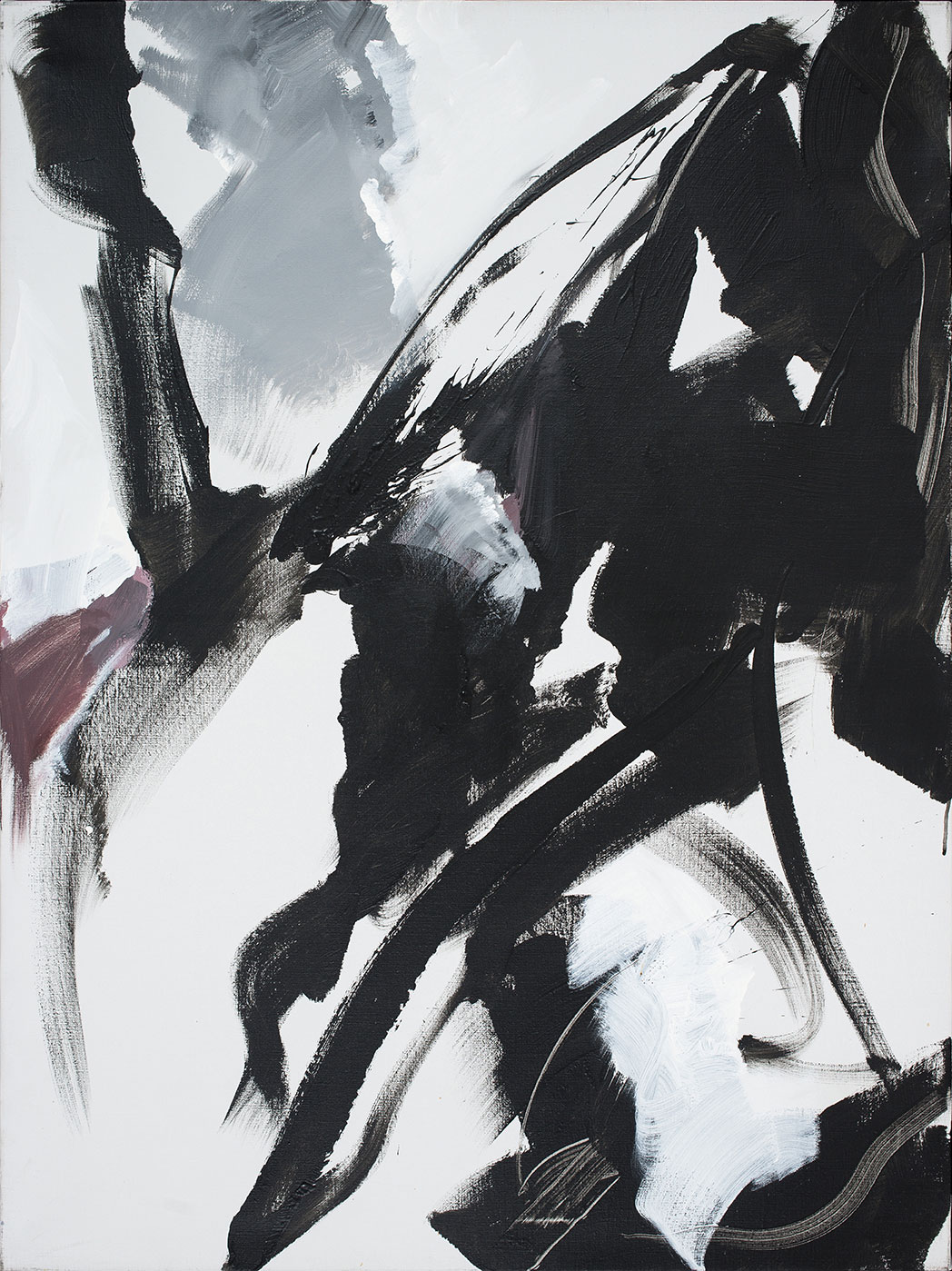
Untitled – 1997
Acrylic on canvas
133 x 100 cm – 52.4 x 39.4 in.
Signed and dated ‘Miotte 1997’ on reverse
“Spontaneous painting and harmony between impulse and balance.”
Karl Ruhrberg
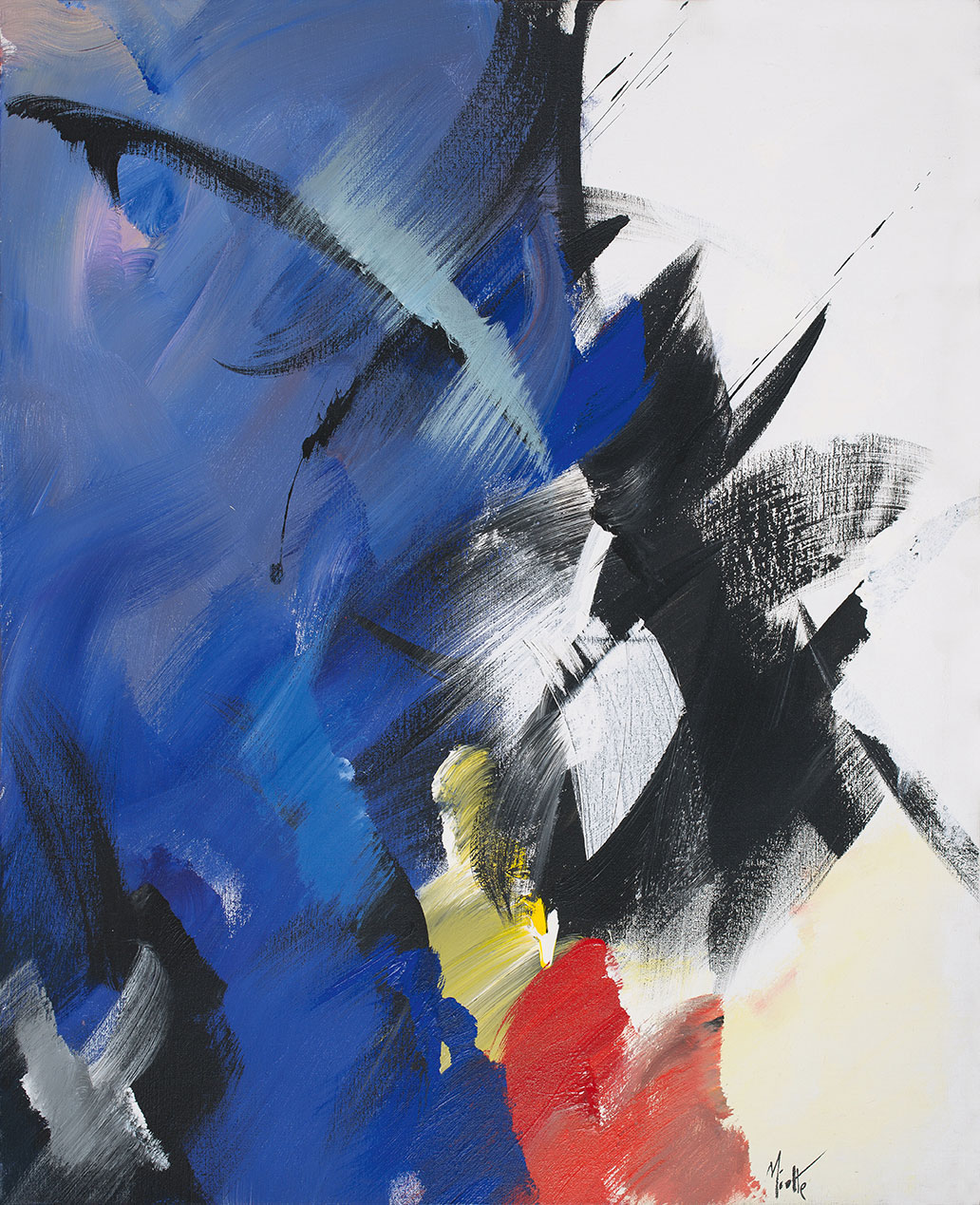
Untitled – 1996
Acrylic on canvas
100 x 81 cm – 39.4 x 31.9 in.
Signed ‘Miotte’ lower right
Signed ‘Miotte’ on reverse
“A gestural painter in the French spirit, Miotte expresses himself in the constructive despite the impression of immediate vehemence that emanates from his paintings: his art goes beyond the post-war aesthetic, standing out in a more modern way by a conscience of the independence of the idea of creating.”
José-Augusto França
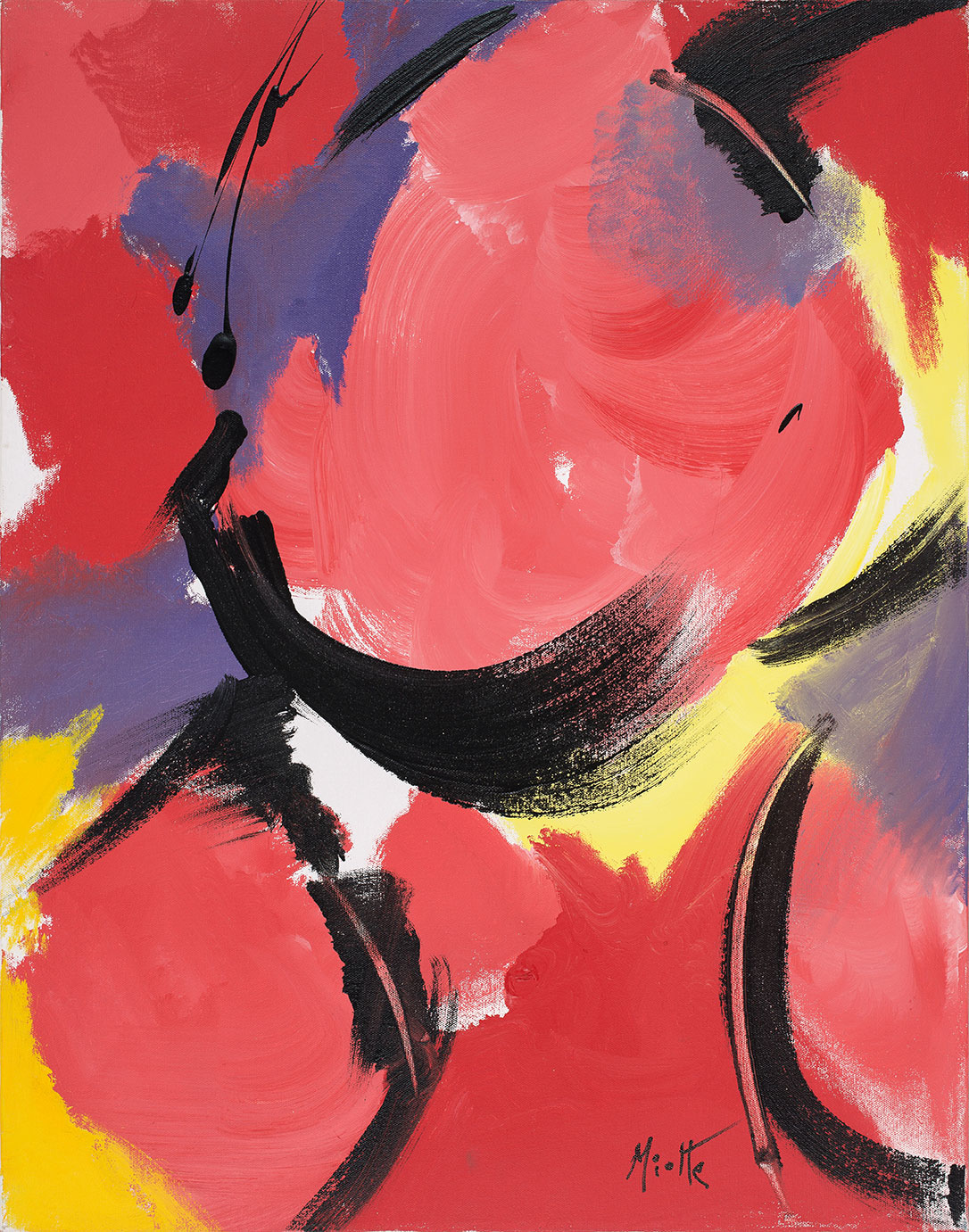
Au début – 2000
Acrylic on canvas
71 x 56 cm – 28 x 22 in.
Signed ‘Miotte’ lower right

Untitled – 2001
Acrylic on canvas
56 x 71 cm – 22 x 28 in.
Signed ‘Miotte’ lower right
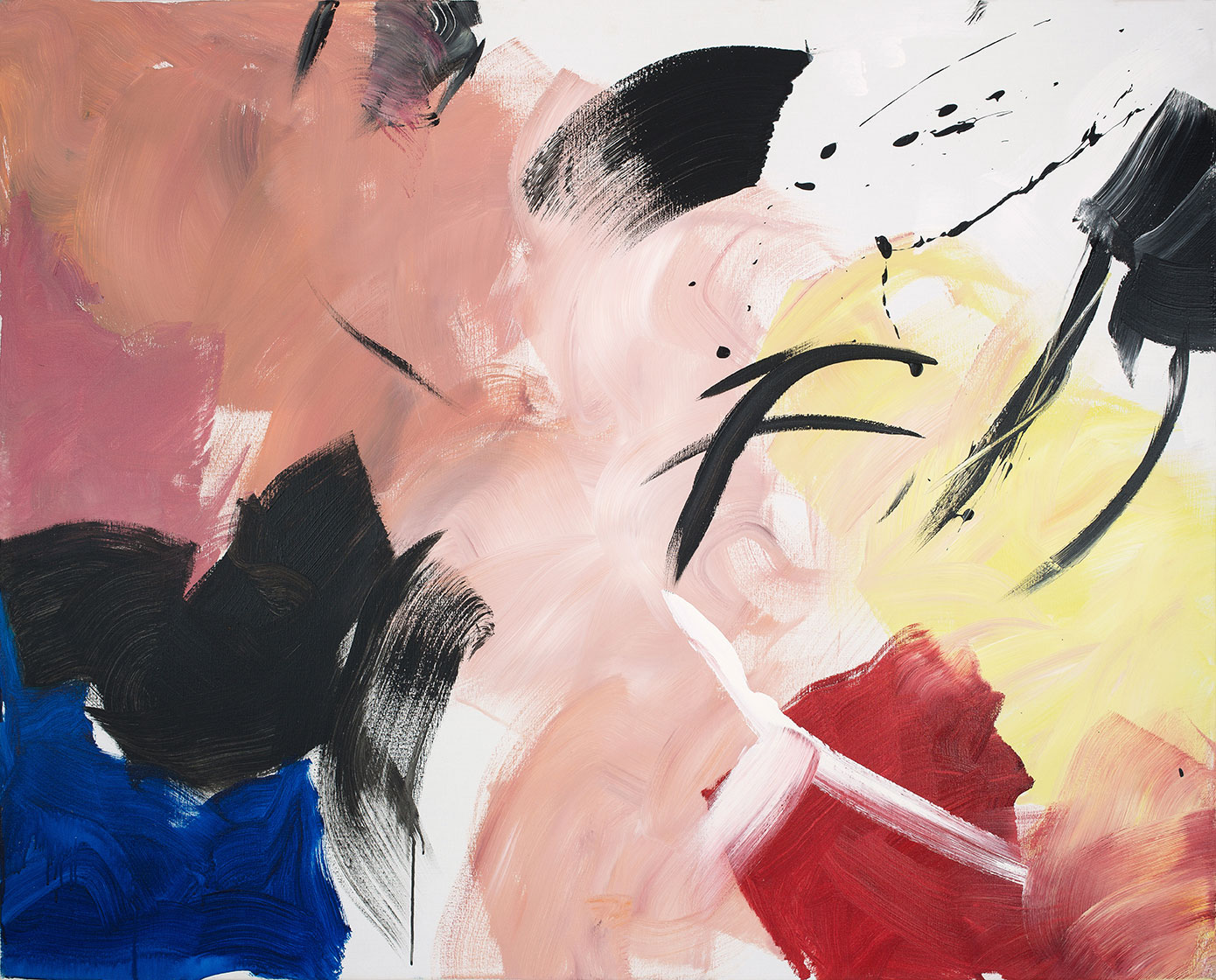
Untitled – 2000
Acrylic on canvas
130 x 162 cm – 51.2 x 63.8 in.
“Movement is my life”
Jean Miotte

Untitled – 2000
Acrylic on canvas
100 x 81 cm – 39.4 x 31.9 in.
Signed ‘Miotte’ lower left
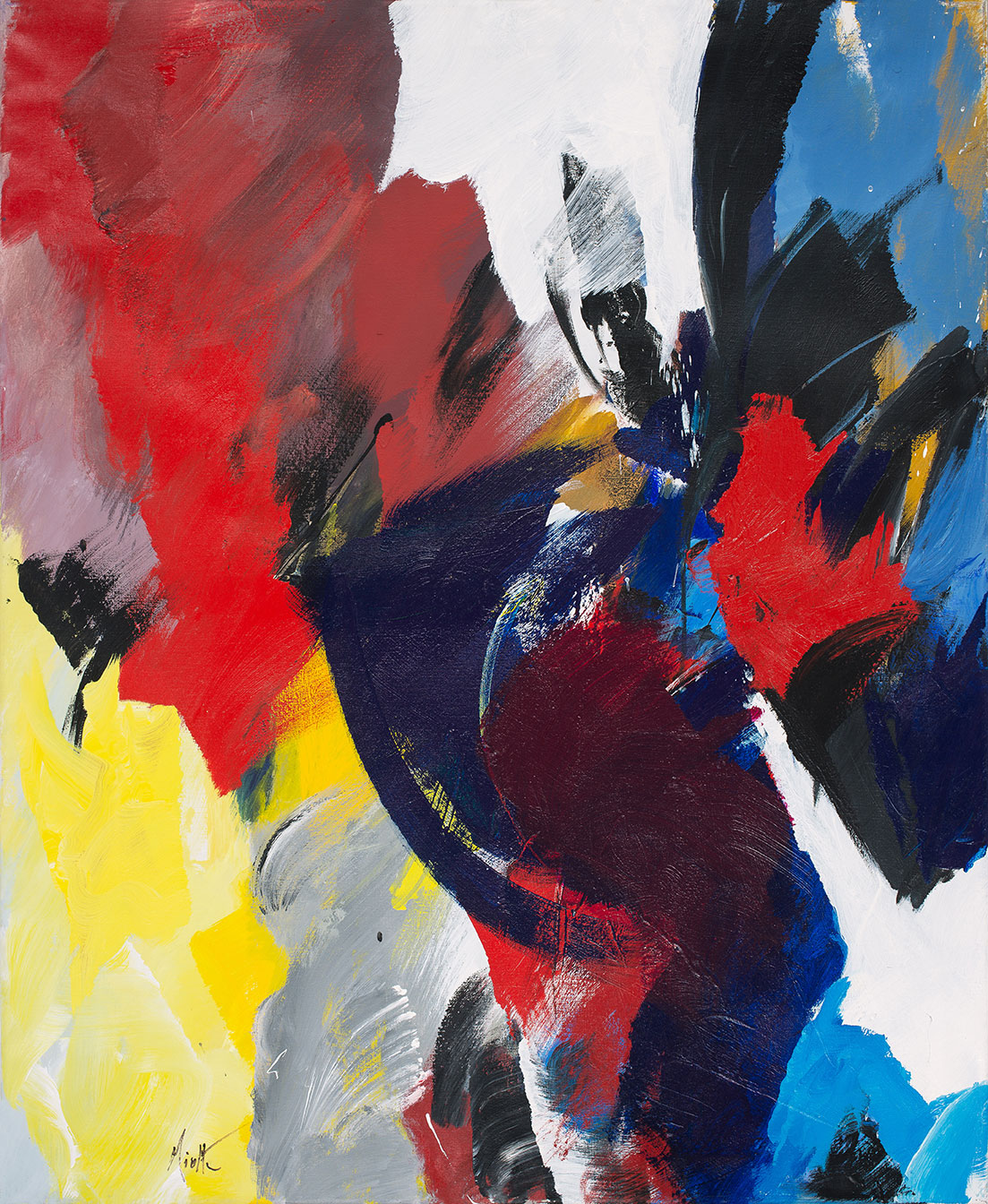
Embrasement – 2001
Acrylic on canvas
100 x 80 cm – 39.4 x 31.5 in.
Signed ‘Miotte’ lower left

Untitled – 2001
Acrylic on canvas
195 x 390 cm – 76.8 x 153.5 in.
Signed ‘Miotte’ lower right
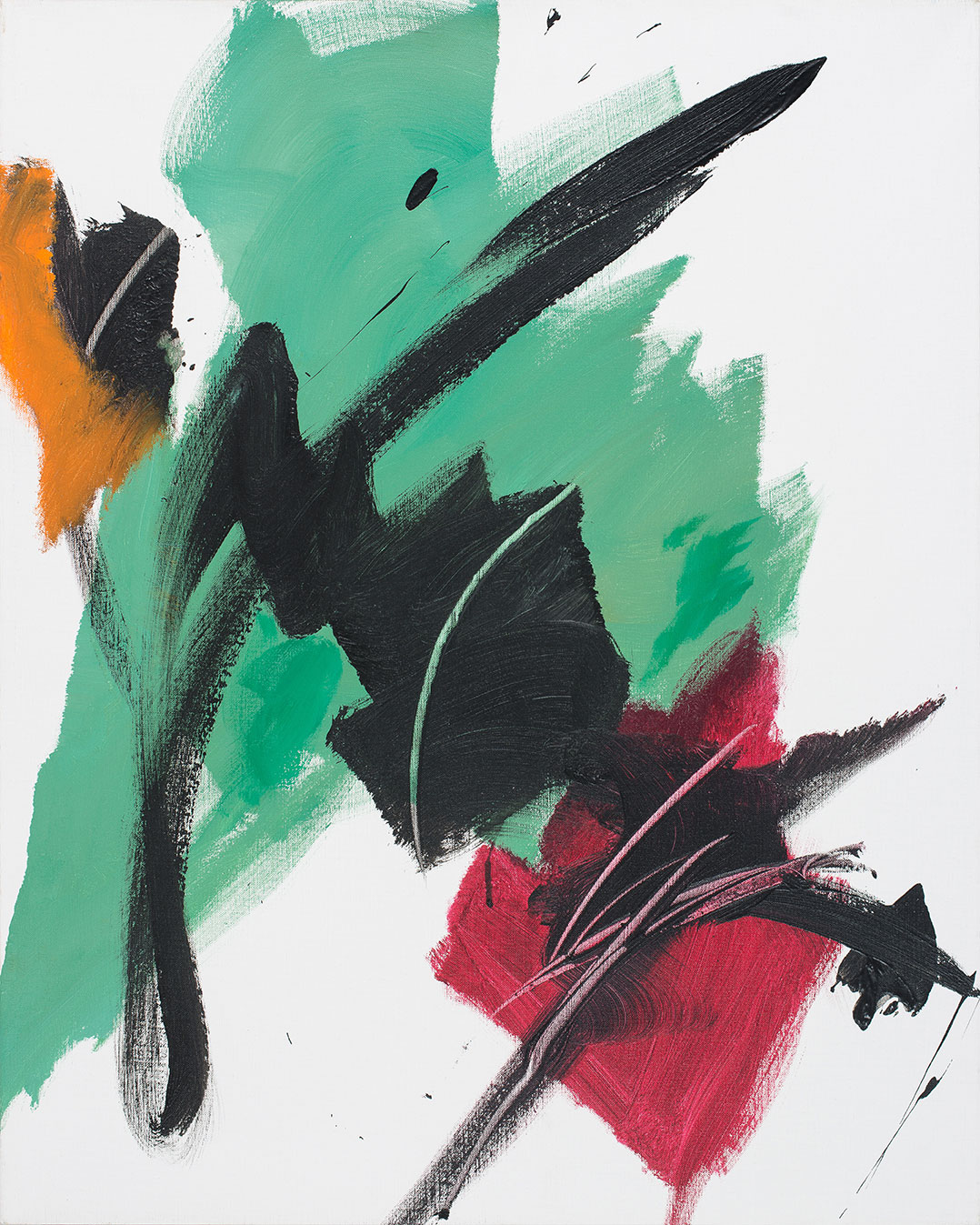
Une décision – 2002
Acrylic on canvas
76 x 61 cm – 29.9 x 24 in.
Signed ‘Miotte’ on reverse
“Beyond all realistic figuration, it is an event in itself that finds its expression in the gestural dynamic and its equivalence in colour… knowing how to combine the contradictory in the form seems possible for Miotte, serenity battles chaos, gentleness and the savage rub shoulders in happiness.”
Castor Seibel

La cascade – 2004
Acrylic on canvas
76 x 61 cm – 29.9 x 24 in.
Signed ‘Miotte’ lower right

Untitled – 2005
Acrylic on canvas
61 x 51 cm – 24 x 20.1 in.
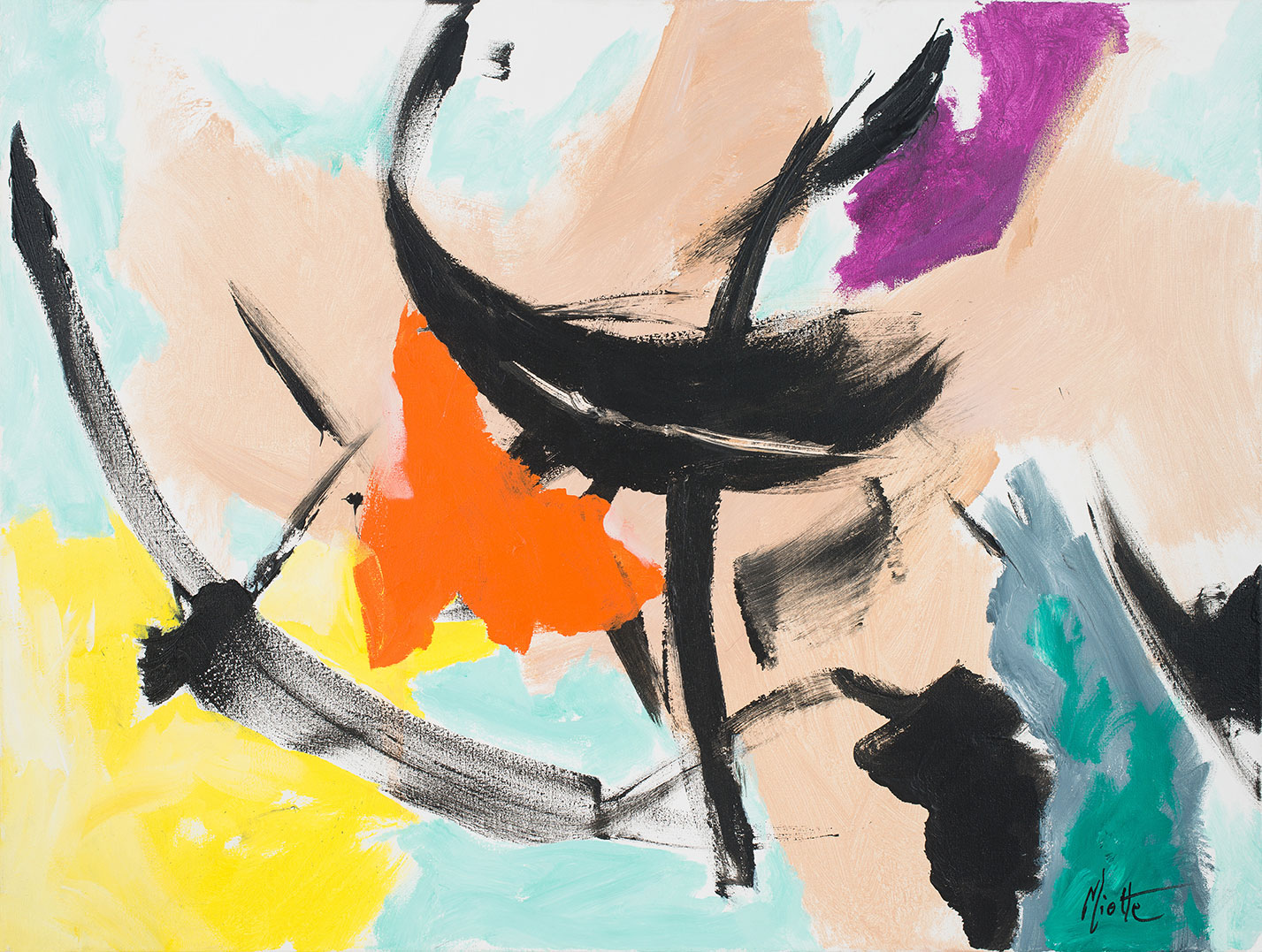
Untitled – 2006
Acrylic on canvas
60 x 80 cm – 23.6 x 31.5 in.
Signed ‘Miotte’ lower right
Signed ‘Miotte’ on reverse on the stretcher
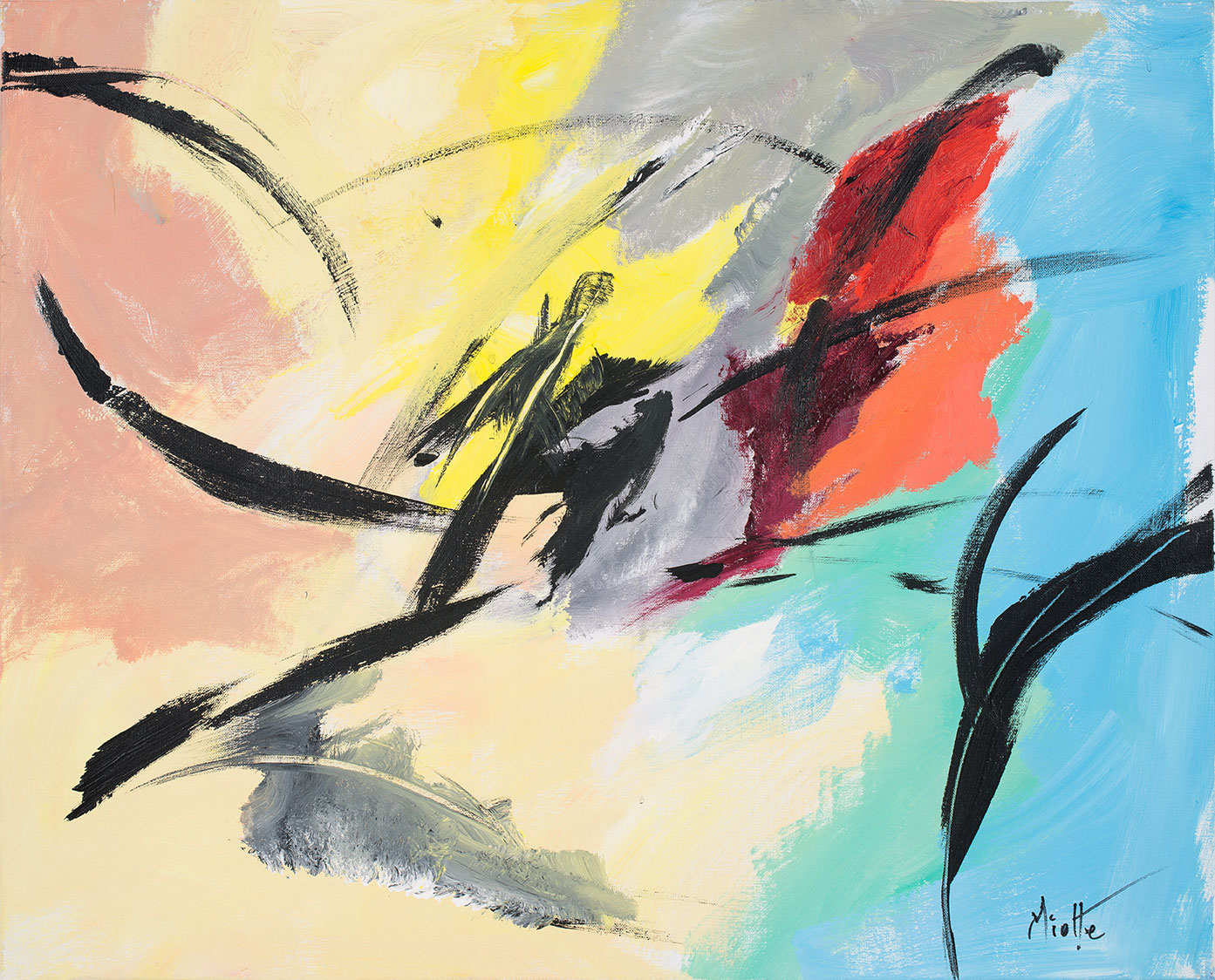
Étreinte – 2008
Acrylic on canvas
65 x 80 cm – 25.6 x 31.5 in.
Signed ‘Miotte’ lower right
Titled and dated ‘Étreinte 2008’ on reverse
BIOGRAPHY
THE YEARS OF STUDIES OF THE PAINTER JEAN MIOTTE
Jean Miotte was born in Paris on September 8th, 1926 and spent his youth in Occupied Paris: he was eighteen years old at the end of the war. “It was in this context of upheaval and planetary ideological turmoil that his desire for other values, other spiritual commitments was exacerbated. His hostility towards all forms of regimentation, group effects, dates from this time. At the age of nineteen, he had decided, his path would be solitary” wrote Serge Lenczner.
After studying mathematics, Jean Miotte discovered painting during his military service in 1946. He painted the walls of the barracks and said: “I had been struck by the ugliness of the place and the surrounding wall decorations and I swore that as soon as I could I would transform it.” After this, Jean Miotte painted frescoes and theatre sets.
In 1947, Jean Miotte went to the studios of the painters Émile Othon Friesz and Ossip Zadkine. The same year, suffering from tuberculosis, Jean Miotte was hospitalized for many months during which he painted and made drawings. When he left, he painted from life and also created a few imaginary compositions.
THE IMPORTANCE OF DANCE TO JEAN MIOTTE’S ART
The painter Jean Miotte was influenced by the art of Jacques Villon, Georges Rouault and Henri Matisse. He was invited to London by the Ballets Russes and to Monte-Carlo by friends who were dancers and choreographers. Dance is a vital element in his art. Jean Miotte was surrounded by friends who were dancers and choreographers such as Zizi Jeanmaire and Wladimir Skouratoff. Jean Miotte’s first figurative paintings often show dancers. Jean Miotte’s painting was nurtured by theatre and performance. He dreamed of a synthesis of music, painting and choreography. Jean Miotte received a commission from the city of Paris: a large format work entitled Sud which hangs in the main hall of the Bastille Opera House. The writer Castor Seibel wrote about Jean Miotte’s painting: “Beyond all realistic figuration, it is an event in itself that finds its expression in the gestural dynamic and its equivalence in colour… knowing how to combine the contradictory in the form seems possible for Miotte, serenity battles chaos, gentleness and the savage rub shoulders in happiness.”
JEAN MIOTTE’S EARLY SUCCESSES
Jean Miotte travelled to Italy and discovered Quattrocento art. He also met the artists Piero Dorazio, Lorenzo Guerrini and Achille Perilli. On returning to Paris, Jean Miotte was influenced by the paintings of Robert Delaunay and Fernand Léger.
In 1950, Jean Miotte made his first abstract painting. At the time, he was living and working at Meudon where he met the artists Jean Arp and Gino Severini. In 1952, Jean Miotte met Sam Francis and visited his studio at Ville-d’Avray. The following year Jean Miotte exhibited at the Salon des Réalités Nouvelles for the first time; he would continue to exhibit regularly there. The same year, the art critic Michel Seuphor contacted him for his publication Dictionnaire de l’art abstrait which was published in 1957. Miotte’s painting is described in it as: “highly coloured compositions with
clearly articulated design that have wall power.” Jean Miotte is a personal work, between Lyrical Abstraction, Informal Art and Tachisme. “The names of the artists who, with their lyricism, are an exception to the general rule of coldness…Jean Miotte, by whom bright and airy painting transmits an undeniable emotion,” wrote the art critic Alain Jouffroy. Jean Miotte’s paintings were created with an immediate gesture, a dazzling energy. “Movement is my life” he recalled. In this, he can be compared to Jackson Pollock.
Jean Miotte never prepared his work with sketches. This differentiated him from Hans Hartung for example. The American art critic Harold Rosenberg appreciated this practice especially: “the most important thing in art is freshness”.
This free and instinctive form of painting was also influenced by Surrealism. The spirit was liberated of all constraints of reflection: “it is the intuition that counts above all when a work is born”. Jean Miotte evoked his work as the “result of internal conflicts, my painting is a projection; a succession of acute moments where creation happens in full spiritual tension. Painting is not a speculation of the mind or the intellect, it is a gesture that is carried within.” Jean Miotte met Roberto Matta who told him: “Surrealism is for me a battle. (…) You, too, you’re a fighter, you’re like me, your paintings aren’t abstract.”
The influence of Cubism is also present. Just as his predecessors decomposed to recompose, Miotte “unmakes”. According to Karl Ruhrberg, with Jean Miotte, it is “the orchestration of a world that explodes”. He also underlined Jean Miotte’s strong connection to his northern origins, especially Frans Hals, “who, like him allied spontaneous painting and harmony between impulse and balance.” In 1954, Jean Miotte moved his studio to the townhouse of the sculptor Prince Youriévitch in Boulogne, where the artists Jacques Lanzman and Serge Rezvani were also living. The following year, the painter Henri Goetz brought his pupils to visit this studio.
In 1957, Jean Miotte participated in the exhibition 50 Ans d’Art Abstrait at the Galerie Creuse in Paris. A solo exhibition of his work was held at the Galerie Lucien Durand in the same city. From 1958, Jean Miotte was represented in Europe by the dealer Jacques Dubourg. That year, Jean Miotte met the painters André Lanskoy, Serge Poliakoff and Pierre Dmitrienko.
Jean Miotte became successful in Germany where ten exhibitions were devoted to his work during the 1950s, for example at the Kunsthalle of Recklinghausen in 1958. He was also included in a group exhibition of fifteen painters at the Cologne Kunstverein. The first work by Miotte to enter a museum was acquired by the Ludwig Museum of Cologne in 1960.
THE PAINTER JEAN MIOTTE’S FIRST TRIP TO THE USA
Jean Miotte exhibited at the first Paris Biennale in 1959 in the “Section Informels” with Raymond Hains, LeRoy Neiman, Peter Foldes and André Favory. The following year, two paintings by Jean Miotte were included in the inaugural exhibition of the Galerie Karl Flinker in Paris. Paintings by him were also included in the inaugural exhibition of the Galerie Iris Clert. In 1961, Jean Miotte participated with Sam Francis, Georges Mathieu and Jean-Paul Riopelle in the group exhibitions of the Galerie Swenska-Franska in Stockholm and the Galerie Bonnier in Lausanne. That year, he was awarded the Ford Foundation Prize and was invited to spend six months in the USA. The following year, a solo show of his work was organized by the Iolas Gallery in New York. Jean Miotte met the American artists Robert Motherwell, Mark Rothko, Chaïm Jacob Lipchitz and Alexander Calder. He travelled around the USA and gave alecture at Colorado Spring University.
INTERNATIONAL RECOGNITION FOR THE PAINTER JEAN MIOTTE
In 1963, a Jean Miotte retrospective was organized by the Stedelijk Museum of Schiedam and it then transferred to the Gronginger Museum in the Netherlands. Jean Miotte participated the same year in the group exhibition Art Contemporain at the Grand Palais in Paris. In February 1964, the Portuguese art historian José-Augusto França wrote about Jean Miotte’s painting in the magazine Costruire: “A gestural painter in the French spirit, Miotte expresses himself in the constructive despite the impression of immediate vehemence that emanates from his paintings:
his art goes beyond the post-war aesthetic, standing out in a more modern way by a conscience of the independence of the idea of creating.”
During the 1960s, many exhibitions of Jean Miotte’s work were organized in Germany, the Netherlands, Denmark and in Belgium. At that time, he worked in the south of France, at Pignans. In 1967, he was again included in an exhibition at the Schiedam Stedelijk Museum, the group show Huit peintres de Paris, along with Chafik Abboud, Olivier Debré, Karskaya, Jean Messagier, Carl Moser, Louis Nalard and Paul Rebeyrolle.
In 1970, Jean Miotte became a member of the Comité des Réalités Nouvelles. He exhibited forty paintings at the Fondation Prouvost at Marcq-en-Baroeul. In 1971, Jean Miotte started using hessian bare canvas as an element in his compositions.
The following year, he again spent time in the USA, this time in New York and Washington. Forty-six of his canvases were exhibited at the International Monetary Fund in Washington. Jean Miotte moved his studio to Hamburg in Germany.
In 1975, a monograph on Jean Miotte was published, containing a text by the dealer Castor Seibel: “no imitation, no reproduction, but the internal event finds its expression in the colours and a gestural dynamic… Miotte’s painting is a place where the contradictions of our age are no longer expressed in a dualist way…. In this sense, J.M. is an important creator of new forms.”
The following year, Jean Miotte experimented with paper as a support and made eighty gouaches as well as collages of brown paper and newspaper. One of his works was acquired by the Museum of Maassluis in the Netherlands. He exhibited in Padua alongside Enrico Baj, Alexander Calder and Karel Appel. Jean Miotte moved his studio to Vitry. He exhibited at the Malines cultural centre in Belgium at the group show Kunst in Europa 1920-1960 which brought together the big names in contemporary art of the time.
In 1978, Jean Miotte was invited to speak in the context of exhibitions of his work at the French cultural centre in Damascus and then at the museum of Alep in Syria and finally in Amman in Jordan. The same year, he moved his studio to New York where he was represented by the Martha Jackson Gallery.
His work was shown at exhibitions about French painting from the 1950s at the Maison de la culture de Grenoble, at the Musée de Dunkerque and at the Musée de Saint-Omer in France.
JEAN MIOTTE’S TRAVELS IN ASIA
In May 1980, Jean Miotte exhibited fifty works in Beijing at the French cultural centre. He was the first western painter to be invited to exhibit his work in Beijing after Mao’s death. Jean Miotte took this opportunity to travel around China. In 1982, he exhibited sixty paintings at the Hong Kong Art Center and then at the Institut Franco-Japonais of Tokyo. The following year, Jean Miotte exhibited at the Singapore National Museum and at the National Museum of History of Taipei. In 1984, he was exhibited at the Striped House Museum of Tokyo.
The Guggenheim Museum acquired two works on paper by Jean Miotte in 1987. In 1991, the Centre Georges Pompidou in Paris exhibited the prints commissioned by Danielle Mitterrand for her album Mémoire de la liberté. Fifty-five artists were involved in this project including Jean Miotte, Roy Lichtenstein, Antoni Tapies, Sam Francis and Robert Rauschenberg. The following year, a Jean Miotte retrospective was organized at the Palais des Arts de Toulouse.
The Jean Miotte Foundation was opened in New York in 2002 with a permanent collection of his works. Jean Miotte died on March 1st, 2016 at the age of 89.
© Diane de Polignac Gallery / Mathilde Gubanski
Translation: Jane Mac Avock

Jean Miotte, Model for a ballet set, 1948

Jean Miotte in his studio, Vitry-sur-Seine, France, 1983
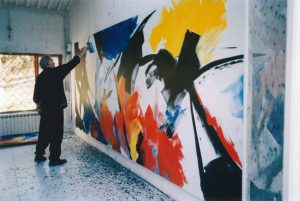
Jean Miotte in his studio, Pignans, France

Jean Miotte’s studio, Soho, New York, 1989
SELECTED COLLECTIONS
Berlin, Graphotek
Castellon, Museo de Arte Contemporáneo de Villafamés
Cologne, Museum Ludwig
Dortmund, Museum am Ostwall
Dhaka, Musée National du Bangladesh
Dunkirk (France), Musée d’Art Contemporain
Hamburg, Staats-und Universitätsbibliothek Hamburg Carl von Ossietzky
Maassluis (Pays-Bas), Gemeentemuseum
Munich, Staatsgalerie Moderner Kunst
New York, The Solomon R. Guggenheim Museum
New York, The Museum of Modern Art
New York, The Chelsea Art Museum
Paris, Musée d’Art Moderne de la Ville de Paris
Paris, Bibliothèque Nationale
Paris, Ministère des Affaires culturelles
Paris, Opéra national Bastille
Paris – La Défense, Fonds national d’art contemporain (FNAC)
Paris – La Défense, Fondation d’Art contemporain CNIT
Rio de Janeiro, Museo de Arte moderna
Saarbrucken (Allemagne), Saarlandmuseum, Moderne Galerie
Singapour, Musée National de Singapour
Taichung, Musée des Arts de Taiwan
SELECTED EXHIBITIONS
Salon des Réalités Nouvelles, Paris, 1953. Participated regularly from this date on Exposition d’ouverture, Galerie du Haut du Pavé, Paris, 1954
50 ans d’art abstrait, to coincide with the publication of the Dictionnaire de la Peinture abstraite by Michel Seuphor, Galerie Creuse, Paris, 1957
Galerie Lucien Durand, Paris, 1957
Réalités nouvelles, nouvelles réalités, 13e salon des Réalités Nouvelles, Kunsthalle de Recklinghausen, Recklinghausen (Germany), 1958
Cinq peintres de Paris : Bogart, Bysantios, Jousselin, Miotte, Mihailovitch, Galerie Attico, Rome, 1958
Section Informel : Hains, Miotte, Neiman, Foldes, Favory…, First Paris Biennale, Paris, 1959
15 peintres de Paris, Kolnischer Kunstverein, Cologne, 1959, 1962
Ouverture, Galerie Flinker, Paris, 1960
Ouverture, Galerie Iris Clert, Paris, 1960
Galerie Am Dom, Frankfurt, 1960
Galerie Gunar, Düsseldorf, 1960
Exposition Internationale, Museum Wolfram Von Eschenbach, Wolframs-Eschenbach (Germany), 1961
Sam Francis, Mathieu, Miotte, Riopelle, Galerie Swenska Franska, Stockholm, 1961
Galerie Bonnier, Lausanne, 1961
Drian Gallery, London, 1961
Centre Culturel de Mechelen, Mechelen (Belgium), 1961, 1976
Galerie Iolas, New York, 1962
Galerie Jacques Dubourg, Paris, 1963
Stedelijk Museum, Schiedam (The Netherlands), 1963, 1967
Musée de Groningen, Groningen (The Netherlands), 1963
Galerie Zodiaque, Brussels, 1963
Grand Palais, Paris, 1963, 1988
Cobra et l’Informel : Appel, Constant, Corneille, Miotte, Riopelle, Tal Coat, Galerie Krikhaar, Amsterdam, 1965
Galerie Dierks, Aarhus (Denmark), 1966, 1968, 1971
Court Gallery, Copenhagen, 1966
Galerie Bio, Aalborg (Denmark), 1967
International graphies, The Corcoran Gallery of Art, Washington DC, 1970
Galerie Wünsche, Bonn, 1970, 1974, 1976
Septentrion, Centre artistique de la Fondation A. Prouvost, Marcq-en-Baroeul (France), 1970
Huit Peintres de Paris : Abboud, Debré, Karskaya, Messagier, Moser, Miotte, Nalard, Rebeyrolle, Maison de la Culture, Bourges, 1971
International Monetary Fund, Washington DC, 1972
Galerie Dinastia, Lisbon, 1972
Prudhoe Gallery, London, 1973, 1974
Galerie Winter, Braunschweig (Germany), 1975, 1978
Galerie Nieuwe Weg, Doorn (The Netherlands), 1976, 1979, 1984, 1991
Cinq artistes : Appel, Baj, Calder, Miotte, Scordia, Galerie Alfiere, Padua, 1976
Bishops Gallery, Melbourne, 1977
Damascus Cultural Center, Damas, 1978
National Museum, Alep, 1978
Amman Cultural Center, Amman, 1978
Musée de Dunkerque, Dunkirk, 1978, 1993
L’Abstraction des Années 50 en France, Maison de la Culture, Grenoble, 1978
L’Abstraction des années 50 en France, Musée de Saint-Omer, 1978
Travelling retrospective in French cultural centres, 1979
Beijing Cultural Center, Beijing: First exhibition of a western artist in the People’s Republic of China, 1980
Galería Lucas, Gandía (Spain), 1980, 1981
Galerie Koppelmann, Leverkusen (Germany), 1980, 1983
Centre Culturel, Montpellier, 1980
Ayala Museum, Manilla, 1981
Musée de la Poste, Hamburg, 1981
Evergreen Galleries, The Evergreen State College, Olympia, Washington D.C, 1982
Hong-Kong Arts Center, Hong-Kong, 1982
Institut Franco-Japonais de Tokyo, Tokyo, 1982
Trevisan Galleries, Edmonton (Canada), 1982
Paris 59 : Fautrier, Feraud, Hartung, Lanskoy, Lipsi, Miotte, Schneider, Sonderborg, Soulages, TaI Coat, Tapies, Galerie Koppelmann, Cologne, 1982
National Museum de Singapour, Singapour, 1983
National Museum of History, Taipei, 1983
Bitran, Chu teh-Chun, Hartung, Miotte, Soulages, Chapelle des Franciscains, Saint-Nazaire, 1983
Galerie La Cité, Luxembourg, 1983, 1987
Striped House Museum, Tokyo, 1984
Vik Gallery, Edmonton (Canada), 1984
Institut Français d’Athènes, Athens, 1984
Deux peintres, deux sculpteurs, Orangerie de Bagatelle, Paris, 1984
Opus Gallery, Miami, 1985
Konstmassan, Stockholm, 1985, 1989
Art Atrium, Stockholm, 1985
Columbia University, New York, 1986
Galerie Keeser, Hamburg, 1987, 1989, 1991
Les Peintres autour d’Arrabal, Musée d’Histoire, Esch-sur-Alzette, Luxembourg, 1987
Ciae, Chicago International Art Exhibition, Chicago, 1987
Colloque Euro-Arabe, National Museum of Malta, Malta, 1987
Art in Paris, Pavillon Inter-Continental, Singapour, 1987
Galerie Gimpel & Weitzenhoffer, New York, 1988
Galerie Egelund, Copenhague-Holte, 1988, 1990
Espace d’Art Contemporain E. Ungaro, La Rochelle, 1988
Rencontres écrites, Institut du Monde Arabe, Paris, 1988
Les années 50 : Benrath, Chu teh-Chun, Debré, Dietrich Mohr, Féraud, Hartung, Lanskoy, Miotte, Music, Père, Pichette, de Staël, Subira Puig, Casino de Hyeres, Hyères, 1988
Les années 50, Mécénat Pernod, Paris-Créteil, First venue of a travelling, 1988
Galerie N’namdi, Detroit, 1989
Miotte/Arrabal, Maler und Dichter, Institut Français de Hambourg, Hamburg, 1989
Galerie von Braunbehrens, Munich, 1990, 1992, 1996
Galerie Wild, Frankfurt, 1990, 1992, 1994, 1997
Abstrakte Malerei nach 1945 : Miotte, Noël, Schumacher, Sonderborg, Thieler, Haus Sandreuther, Riehen-Basel, 1990
Art et Partage, Musée des Beaux-Arts, Nice, 1990
Musée Seibu, Tokyo, 1991
Galerie Jade, Colmar, 1991, 1992
Galerie Michael Schultz, Berlin, 1991, 1993, 1997
Mémoire de la Liberté : 55 artists from 23 countries, César, Sam Francis, Miotte, Rauschenberg, Motherwell, Lichtenstein, Tinguely, Tapies, etc., illustrate each article of the Universal Declaration of Human Rights, organized by the Association France Liberté, Centre Pompidou, Paris, 1991
Collections des collections ; de Paul Klee à nos jours, CNIT, Fondation d’Art Contemporain, Paris-La Défense, 1991
Couleurs de la vie, international travelling exhibition of contemporary art under the patronage of Mme Danielle Mitterand, Bibliothèque Nationale, Paris, 1991
Forms of Abstraction, N’namdi Gallery, Birmingham, Michigan, 1991
Palais des Arts, Toulouse, 1992
Galerie Shuyu, Tokyo, 1992
Galerie Saint-Polly, Gunrua (Japan), 1992
Art and Art, Nicaf 92, Yokohama, 1992
Grands formats, Miami Art Fair, Miami, 1992
Art Multiple, Düsseldorf, 1992, 1994
5 artistes des années 50 : Christophorou, Debré, Miotte, Féraud, Koch, Centre Culturel Jean Despas, Saint-Tropez, 1993
Hartung et Miotte, Ishi Gallery, Osaka, 1993
Musée des Cordeliers, Châteauroux, 1994
Œuvres graphiques, Musée Bertrand, Châteauroux, 1994
30 ans Après : Sam Francis, Jean Miotte, Joan Mitchell, Jean-Paul Riopelle, organized by Chapel Art Center, Hamburg and Cologne, 1994, 1995, 1997
Pour la paix et la reconstruction au Liban – 33 peintres, Musée Sursock, Beirut, 1994
Chinesische Kunst nach 1945 in Europa – Eine Gegenüberstellung: Li Di, Chu teh-Chun, Zao, Rétrospective 1956-1996, Mücsarnok Museum, Budapest, 1996
Les années 1945-1975, Maison de l’Unesco, Paris, 1996
Arrabal, der Lyriker und die Künstler, Dali, Dorny, Miotte, Saura, Gutenberg Museum, Mayence (Germany), 1996
The Garner Tullis Donation, The Ackland Art Museum, Chapel Hill, NC, 1996
Museum Am Ostwall, Dortmund, 1997, 1999, 2000
Ont-ils du métier ? Propositions pour l’art vivant – Agam, Boltansky, César, Claisse, Cruz. Diez, Hains, Honegger, Messager, Miotte, Morellet, Nemours, Soto, Tinguely, Vasarely, Venet…, Galerie Denise René, Paris, 1997
Grenzganger (qui traversent la frontière) : Sandro Chia, lan Hamilton Finlay, Markus Lüppertz, Jean Miotte, A.R. Penck, Bernd Zimmer, for the 200th anniversary of Heinrich Heine, Kunsthalle Düsseldorf, Staatsgalerie Stuttgart, Goethe institut Paris and Marseille, Villa Romana, Florence, 1997
20 ans d’exposition, Museum Haus Ludwig für Kunstausstellungen, Saarlouis, 1997
Arbeiten auf Papier (works on paper), Kunstmarkt Dresde, Dresde, 1997
The National Arts Club, New York, 1998
Van Der Togt Museum, Amsterdam-Amstelveen, 1998
Villa Haiss, contemporary art Museum, Zell A.H. (Germany), 1998, 2000
Musée d’Art et d’Histoire, Fribourg (Switzerland), 1999
Museum Ludwig, Koblenz (Germany), 2000
Aboa Vetus Ars Nova Museum, Turku (Finland), 2000
Museum of Brno (Czech Republic), 2002
Chelsea Art Museum, New York, 2003, 2005
Museo Fundacion Cristóbal Gabarrón, Valladolid (Spain), 2005
Artrium, Geneva, 2005
Bibliothèque nationale de Nice, Nice, 2005
Jean Miotte, Galerie Diane de Polignac, Paris, 2019
Jean Miotte, Galerie Diane de Polignac, Paris, 2021
SELECTED BIBLIOGRAPHY
Michel Seuphor, Dictionnaire de la peinture abstraite, Paris: Fernand Hazan, 1957
Sam Francis, George Mathieu, Jean Miotte, Charles Maussion, Jean-Paul Riopelle, exhibition cat., Cologne: Kunstverein, 1962
Karskaya, Debré, Abboud et autres, exhibition cat., Bourges: Maison de la Culture de Bourges, 1972
Michel Ragon, Histoire de l’art abstrait, vol. IV, Paris: Maeght, 1975
José-Augusto França, Castor Seibel, Miotte, Paris: La Porte Verte, 1975
Chester Himes, Miotte, Palaiseau: SMI (L’art se raconte), 1977
Jean Miotte (text), Écriture et signes, exhibition cat., Athens: Institut français d’Athènes, 1984
Gérard Xuriguera, Les années 50, Paris: Arted, 1985
Fernando Arrabal, Jean Miotte, Devoirs de vacances, été 85, Paris: Galilée, 1986
Marcelin Pleynet, Miotte, OEuvres sur papier 1950-1965, Paris: Galilée, 1987
Marcelin Pleynet, Miotte, Paris: Éditions de la Différence, 1987
Claude Michel Cluny, Miotte, Peintures et Gouaches, Paris: Éditions de la Différence (L’Autre Musée), 1989
Mustapha Chelbi, L’affiche d’art en Europe, Paris: Van Wilder, 1989
Jean-Luc Chalumeau, Miotte, Paris: Fragment (Passeport), 1990
Michel Bohbot, Miotte, Le Geste majeur, Paris: Navarra, 1991
Mémoire de la liberté, exhibition cat., Paris: Centre Georges Pompidou, 1991
Jean-Clarence Lambert, Le règne imaginal, Paris: Cercle d’Art (Diagonales), 1992
Lydia Harambourg, L’École De Paris, 1945-1965 : Dictionnaire des peintres, Lausanne: Ides et Calendes, 1993
JEAN MIOTTE
Un geste qu’on porte en soi
Harmonie, impulsion, équilibre
EXPOSITION : 15 SEPTEMBRE – 10 OCTOBRE 2022
EXHIBITION: SEPTEMBER 15 – OCTOBER 10, 2022
Galerie Diane de Polignac
2 bis, rue de Gribeauval – 75007 Paris
www.dianedepolignac.com
Texte – text: Lydia Harambourg
Traduction – translation: Jane MacAvock / Lucy Johnston
© OEuvres : ADAGP, Paris, 2022
Photographies des oeuvres : Droits réservés
© Artworks: ADAGP, Paris, 2022
Photographs of the works: Reserved rights
© Galerie Diane de Polignac, 2022
